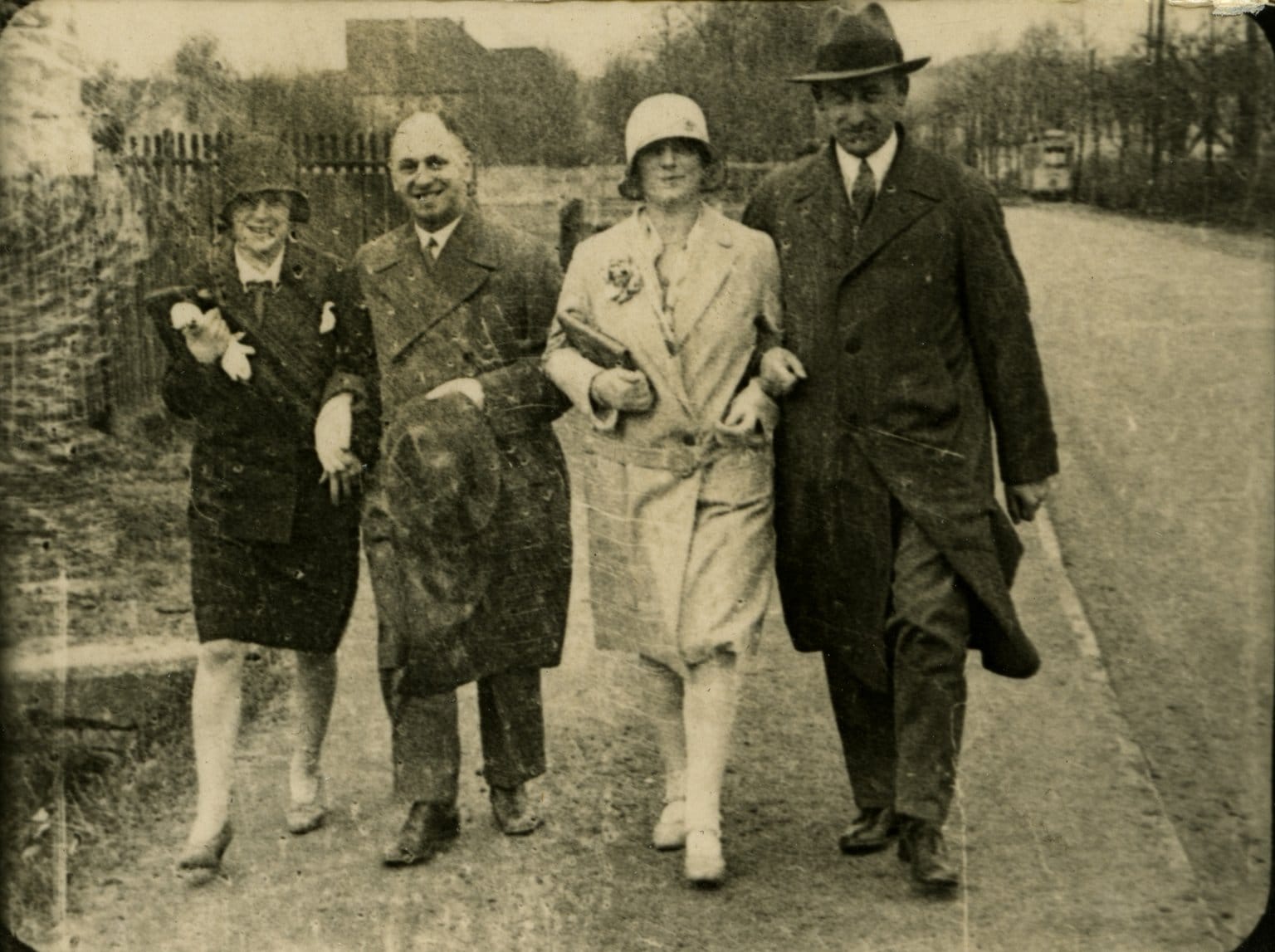Unveiling the Life of Auguste van Pels
This is the story of Auguste van Pels, a woman whose life unfolded against the backdrop of the Holocaust. While many know her from the pages of Anne Frank’s diary, Auguste’s life extended far beyond her time in hiding. She was a woman of strength, resilience, and love, facing unimaginable challenges with a quiet determination that continues to inspire us today.
Born Auguste Röttgen in Germany in 1900, she experienced the rising tide of antisemitism during her childhood in Osnabrück. Seeking a safer life, Auguste and her family made the difficult choice to seek refuge in the Netherlands in 1937. Little did they know, a different kind of storm was brewing on the horizon.
Life took an unexpected turn for Auguste when she and her family crossed paths with the Frank family. Bound together by circumstance and a shared hope for survival, they found themselves seeking refuge in the cramped confines of the Secret Annex in Amsterdam beginning in 1942. It was here that their lives became deeply interwoven.
Within the walls of their hidden world, Auguste, affectionately known as “Petronella” by those in hiding, embraced the role of a resourceful homemaker. Anne Frank, in her diary, referred to Auguste as the “Queen of the Kitchen,” a testament to her ability to create a sense of normalcy and comfort amidst the constant fear and uncertainty.
Anne’s diary offers us a glimpse into the complex dynamics between those in hiding. Auguste, often portrayed as practical and level-headed, faced the challenges of confinement and the strain it put on her marriage with quiet strength. While Anne’s writings suggest that Auguste and her husband, Hermann, had their disagreements, perhaps amplified by the stress of their situation, their bond seems to have endured.
Tragically, the relative safety of the Annex was shattered on August 4, 1944, when a devastating betrayal led to their discovery and arrest. Torn from their hiding place, Auguste, along with the others, was sent to the Westerbork transit camp, a way station on the horrifying path to the concentration camps.
Their journey into the abyss continued with their deportation to Auschwitz-Birkenau. It was here that Auguste was separated from her loved ones, the pain of their absence adding another layer to the horrors she faced.
Eventually, Auguste found herself transferred to the Bergen-Belsen concentration camp. Weakened by the unimaginable hardships she had endured, she tragically succumbed to the deplorable conditions in April 1945, just a short time before the camp’s liberation.
Auguste van Pels: Key Points
- Auguste van Pels (née Röttgen) was born in Germany in 1900 and experienced antisemitism during her childhood.
- She fled Germany to the Netherlands in 1937 due to rising Nazi persecution.
- Auguste and her family went into hiding with the Frank family in the Secret Annex in Amsterdam in 1942.
- Known as “Petronella” in the Annex, Auguste was a resourceful homemaker and provided comfort and stability.
- She faced challenges in her marriage due to the stress of confinement but maintained her bond with her husband.
- The Annex was discovered in August 1944, and Auguste was arrested and sent to the Westerbork transit camp.
- She was deported to Auschwitz-Birkenau and later transferred to Bergen-Belsen.
- Auguste succumbed to the harsh conditions in Bergen-Belsen in April 1945, shortly before its liberation.
- Her life story, intertwined with Anne Frank’s diary, showcases her resilience and unwavering love in the face of unimaginable adversity.
- Auguste’s story serves as a reminder of the human cost of prejudice and the importance of fighting injustice and promoting tolerance.
What Happened to Auguste van Pels After She Was Captured?
After sharing a cramped attic with the Frank family for two years, Auguste van Pels’s life took a devastating turn when their safe haven, the Secret Annex, was discovered on August 4, 1944. The Gestapo ripped her away from the only sanctuary she had known, sending her on a journey riddled with unimaginable cruelty. Auguste, along with the other Annex residents, was transported to Auschwitz-Birkenau. It was here that she was tragically separated from her husband, Hermann, and son, Peter, their fates forever intertwined with the horrors of the camp.
The details of Auguste’s final months are shrouded in the chaos and brutality of war. What we do know is that she was moved to Bergen-Belsen, another concentration camp, where conditions were nothing short of horrific. Tragically, Auguste’s strength finally gave out. She died in April 1945, just a few short weeks before the camp was liberated. Her body, likely weakened by starvation and disease, bore witness to the inhumane treatment she endured.
Did Any of the Van Pels Survive?
Sadly, no, none of the Van Pels family members survived the Holocaust. After hiding in the Secret Annex with the Frank family for over two years, their time ran out on August 4, 1944. The Gestapo, acting on a tip from an unknown informant, discovered their hiding place and arrested everyone inside.
Auguste, the mother of the family, was separated from her husband, Hermann, and her son, Peter, upon their arrival at Auschwitz-Birkenau. Tragically, Auguste’s life ended in April 1945 during a transport, although the exact circumstances and location of her death remain unknown.
Hermann and Peter remained together for a while longer, enduring the brutal conditions at Auschwitz until they were transferred to another camp. However, their time together was cut short when Hermann was deemed too weak to work. He was likely sent to the gas chambers, meeting his death sometime in October or November 1944.
Peter, still clinging to hope, found himself deported yet again, this time to the notorious Auschwitz III-Monowitz labor camp. He bravely endured the horrors of that camp until January 1945, when the approaching Soviet army forced the Nazis to evacuate. Peter was among those forced on a death march to Mauthausen concentration camp in Austria. Weakened and ill, he tragically died there on May 5, 1945, just three days before the camp’s liberation.
The Van Pels family’s story, like countless others from this dark period, stands as a stark reminder of the devastating consequences of intolerance and hate. Even today, researchers and historians continue to meticulously piece together the details of these lost lives, ensuring that their stories are never forgotten and serve as a powerful testament to the human cost of prejudice and persecution.
How Old Was Auguste van Pels When She Died?
Auguste van Pels’ life was tragically cut short during the Holocaust. While we don’t know her exact age when she died, we can estimate that she was 44 years old based on historical records and testimonies.
Born Auguste Röttgen in Germany in 1900, she married Hermann van Pels, and they had a son named Peter. Before the horrors of World War II unfolded, they lived a comfortable life in Osnabrück, Germany. However, as the Nazi regime tightened its grip and anti-Semitism spread, they made the difficult decision to flee to Amsterdam in 1937.
They hoped for safety and a new beginning in Amsterdam, but sadly, the shadow of Nazi persecution followed. When the Nazis invaded the Netherlands in 1940, the Van Pels family, along with four other Jewish individuals, sought refuge in a secret annex behind the business of Otto Frank. There they lived in hiding with Otto and his family, including his daughter Anne, who would become famous for her diary.
During their time in hiding, Auguste became a source of strength for the group. Known fondly as the “burgomeester,” or house manager, she managed the household tasks, cooked, cleaned, and provided emotional support to those around her in their confined and uncertain world.
Their hidden world was shattered on August 4, 1944, when the Gestapo, acting on a tip, discovered the annex and arrested everyone hiding there. Auguste, along with the others, was deported to the Auschwitz-Birkenau concentration camp.
Later, Auguste was transferred to the Bergen-Belsen concentration camp. Tragically, it was at Bergen-Belsen that her life likely ended sometime in the spring of 1945, just shortly before the camp’s liberation. The exact circumstances of her death remain unknown, lost to the chaos and brutality of the camp.
Why Did the Van Pels Go Into Hiding?
In 1942, life for Jewish families like the Van Pels was a terrifying reality. The Nazi’s control over Europe meant daily life was overshadowed by danger and uncertainty. For the Van Pels family, the moment to make a life-altering decision came when Hermann and Peter received their call-up notices. These notices weren’t just pieces of paper; they were practically a death sentence, symbolizing the very real threat of forced labor and the horrors of concentration camps.
This looming threat forced the Van Pels family, much like the Franks, to make an unimaginable choice: disappear. They chose to go into hiding, hoping to outlive the nightmare that was engulfing Europe. Their search for safety led them to a secret annex tucked away behind Otto Frank’s business in Amsterdam. This cramped space became their shared refuge with the Frank family for over two years.
Sadly, the annex couldn’t offer them permanent protection. An anonymous betrayal shattered their fragile world. The Gestapo stormed their hiding place, sending both families to concentration camps, where the Van Pels family tragically perished. Their story serves as a stark reminder of the devastating consequences of prejudice and the millions of innocent lives lost during the Holocaust.
Their decision to go into hiding wasn’t a choice driven by cowardice but a desperate act of courage, a fight for survival against overwhelming odds. The Van Pels’ story stands as a testament to the resilience of the human spirit and the devastating consequences of hatred and intolerance.
- Unlock Elemental 2 Secrets: Actionable Insights Now - April 2, 2025
- Lot’s Wife’s Name: Unveiling the Mystery of Sodom’s Fall - April 2, 2025
- Photocell Sensors: A Complete Guide for Selection and Implementation - April 2, 2025
















